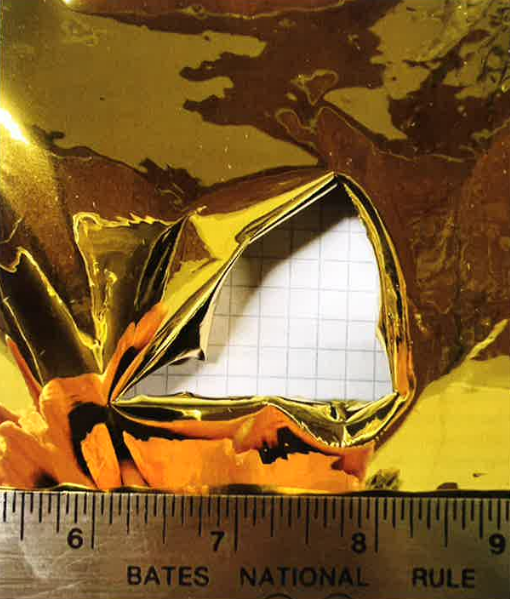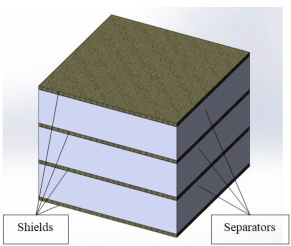Essay: Structures Research on Survivablity of Small Debris Impact
This essay was written for Aerospace Structures
Small orbital debris are a growing problem in Earth orbit; satellites and spacecraft are susceptible to severely damaging impacts from objects too small to track (and thus, impossible to avoid). “Debris” in Earth orbit are generally considered man-made objects that are left in their orbit after a mission, while “small” debris are 1-10 cm long and impossible to count or track from the ground. [2] While larger debris are significantly more dangerous to spacecraft, techniques already exist to deorbit, track, and avoid them; current research focuses on unavoidable impacts with debris fragments. In addition to research on new structures’ impact resistance, the safety of structures on currently-flying missions such as the ISS must be evaluated as flight time and damage from prior impacts accumulate. [4] In 2022, the Air Force Institute of Technology (AFIT) conducted research into survivability of membrane satellite mirrors (e.g. James Webb Space Telescope) against debris fragments present in Earth and Lunar orbits.
The Department of Defense’s (DOD) Survival Technical Committee has sponsored several studies on aerospace structure impact with high-speed fragments associated with aircraft and spacecraft. Studies simulating orbital debris generally fire a projectile at high velocity and examine damage to the structure, sometimes via its response to load conditions; the most dangerous fragments have a velocity of 1-15 km/s. [1], [4] One study computationally simulated an orbital impact with a large object and the resulting debris cloud, which remains hazardous to other structures until every fragment has deorbited. Other AFIT studies focused on impact resistance of vulnerable structures on combat aircraft, such as pressurized fuel tanks and dry cargo bays, against small projectiles from weapons. DOD research on structures in 2022 studied the continued performance of spacecraft mirrors and combat aircraft structures after impact, as well as risk to current vehicles in the air and on orbit. [1]

Gold membrane mirror after impact with a simulated orbital debris fragment [1], AFIT

Simulated collision of a 3.2 mm fragment with a shield plate at 6.8 km/s, 1 μs between frames [3]
Shield structures in aerospace commonly use composites because orbital collisions are highly energetic: a 1 g debris fragment travelling 10 km/s has 50 kJ of kinetic energy, which is equivalent to lifting a 1-ton object by 5 meters on Earth. After the initial impact of a particle with the first layer of a structure, a cloud of much smaller fragments continues to impact the next layer; Whipple shields use a separator between layers to allow the cloud to disperse and reduce stress from the second impact. [3] Structures can use different separator layers depending on their other purposes, e.g. Kevlar laminate for impact resistance or aluminum honeycomb to increase bending stiffness. Simulated impacts with PEEK-overwrapped carbon laminate structures similar to the ISS’s Canadarm predict an 80-90% reduction in ultimate normal and shear strength following a single high-velocity impact. In brittle composite materials, fracture toughness is limited by the largest crack; cyclic compressive loads cause cracks to propagate rapidly before the structure fails. [4] Composite shield structures use internal separation layers to improve their overall strength and stiffness in addition to dispersing the debris cloud following impacts.

Diagram of a composite Whipple shield showing the space between shielding layers [3]
High-velocity collisions in orbit create clouds of untraceable debris that remain a hazard to spacecraft until deorbiting; current research aims to design structures that can withstand orbital impacts and evaluate the risk of debris fragments to currently-flying missions. DOD research in 2022 focused on quantifying the damage caused by impacts to satellite optics, as well as a numerical study on a collision in lunar orbit. Other Air Force studies studied past incidents with helicopters and future improvements to vulnerable structures on combat aircraft. Whipple shields are a composite structure that allow fragments to disperse before their final impact; however, materials can lose the majority of their ultimate strength from a single impact. Resistance to highly energetic collisions with small debris is vital to reduce the statistical risk of spacecraft, and can greatly change the design of a structure.
[2] V. V. Adushkin, O. Yu. Aksenov, S. S. Veniaminov, S. I. Kozlov, and V. V. Tyurenkova. “The Small Orbital Debris Population and Its Impact on Space Activities and Ecological Safety.” Acta Astronautica, 2020.
[3] E. P. Buslov, I. S. Komarov, V. V. Selivanov, V. A. Titov, N. A. Tovarnova, and V. A. Feldstein. “Protection of Inflatable Modules of Orbital Stations against Impacts of Particles of Space Debris.” Acta Astronautica, 2019.
[4] Anne-Marie Lanouette, Marie-Josée Potvin, Francis Martin, Dany Houle, and Daniel Therriault. “Residual Mechanical Properties of a Carbon Fibers/PEEK Space Robotic Arm after Simulated Orbital Debris Impact.” International Journal of Impact Engineering, 2015.
Last modified: 2023-02-08